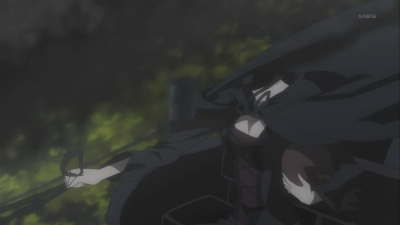
The latest episode of Durarara! helped cement some suspicions I’ve had since it began. Most viewers seem to be keying in on how similar it is to Baccano!, but I haven’t been getting that vibe. Baccano! plays off of all sorts of pulp adventure archetypes and the like, but I wasn’t seeing that with Durarara! The “throw the whole cast out in one episode then go back and piece it all together” method of storytelling was in place, but that was the only real similarity at work.
Nope, Durarara! isn’t pulp. It’s modern-day mythology.
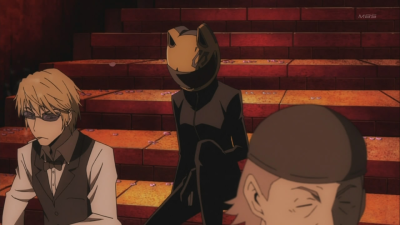
Mythology, legends, and all that shit are stories that were originally passed down orally amongst people back in the day. It was the sort of thing you’d recite over and over again in order for the next generation to remember and recite to their kids, and this proceeded for however many generations until people stated recording it into books. The way Durarara! is using urban legends is playing off of this concept, just in a modern context.
Yeah, those bits with the chatroom text are money-saving visual devices, but they’re also serving a purpose. This is one way that people are spreading these urban legends. They’re retelling stories much in the same way that people would sit around and pass down stories of fairies and gods and monsters in past cultures. These stories about the Headless Biker change depending on who’s telling it, much like how you have multiple versions of the same mythological story depending on where that story comes from. Durarara! is presenting the whole concept of the urban legend as the modern-day myth. Not an original idea, but it’s one that hasn’t been played out enough to come off as tired and clichéd.
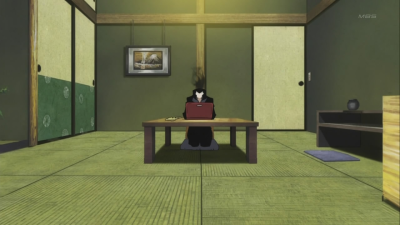
Durarara is also showing what it’d be like to be a mythical being in modern times. Selty, the Dullahan, is the most obvious example. She’s essentially a grim reaper who has lost her ability to do her “job.” She’s searching for the one thing that she believes will return meaning to her life. She’s basically a mythological creature that’s going through the sort of existential crisis that’s so common in modern storytelling. It makes sense that a mythical creature would end up having to face a narrative device that’s standard faire for a modern story. Modern stories relish in “humanizing” even the most inhuman of concepts (Look at most of the recent vampire movies and books to see how a creature that was a force of nature in the original Dracula has been turned into the stuff of young adult fodder.), so seeing a Dullahan go through these motions make perfect sense. By modern standards, she’s not “allowed” to be “above” human problems or else she’ll appear to be unbelievable to the average audience member.
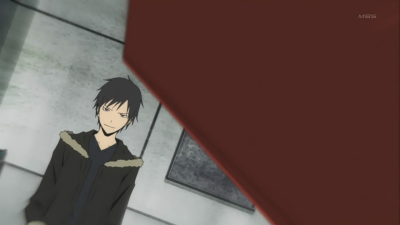
The same goes for other characters in Durarara! Many of the supporting characters demonstrate mythical abilities. Orihara comes off as a trickster god figure, much like Loki from Norse myth or Coyote from various Native American myths. He cares more about toying with the feelings and lives of others and sees himself as somehow “above” all of their concerns. At the same time he has to stoop to paying off Selty to help him and seems to be limited in his capabilities. He comes off as being capable of larger things, but he’s just toying around with some street punks and residents in a neighborhood in Japan. What’s up with that? It seems like his scope has been limited by modern society, as if he can’t show his stuff lest he’s exposed for the world to see.
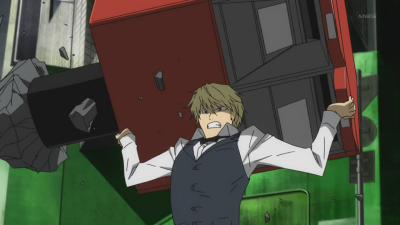
Orihara’s “rival” or sorts, Heiwajima, comes off as some sort of “hero” type. His super-strength makes him seem like Hercules or some other legendary hero. While many of these mythological heroes were subject to hubris, Heiwajima seems to have been brought down even lower than that. He possesses massive strength, but he’s relegated to being a bartender who has trouble keeping a job. Makes sense, since there’s really no need for a “hero” in modern society. There’s no massive quests of exploration and conquest in our world that a mere individual could handle, regardless of his individual prowess. He’s a relic of the past, he’s obsolete, so he has to sink into mundane society.
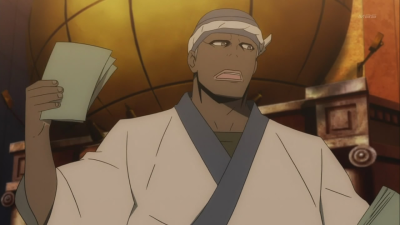
The same goes for the African-Russian, Simon. His very origin sounds like the back story for a mythological hero. Banished from his homeland, he’s found himself twice-removed from his comfort zone (The US and Russia) and finds himself in a strange new country. Yet instead of taking advantage of his own physical prowess he’s reduced to hawking sushi on the street.
In the end, Durarara! seems to be a myth about a world where mythology exists but is obsolete. This isn’t like Princess Mononoke, where mystical creatures are struggling and succeed in finding balance with “progress,” this is a world where that battle has long since been lost. In a way it plays sort of like Hellboy, just with less of an emphasis on the supernatural (so far at least).
It’s a myth where myths are dead.
No comments:
Post a Comment